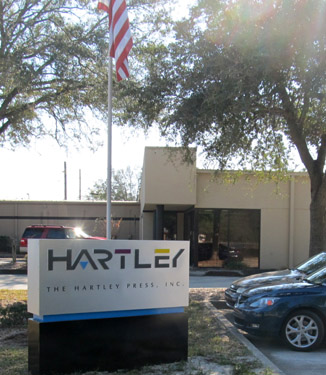"The Palmetto:" the FNPS magazine. Part 2
 |
| Hartley Press in Jacksonville, FL |
The printing company is Hartley Press, a family owned company in Jacksonville, FL. They have been printing and mailing out the Palmetto magazines in full color for FNPS since Marjorie become the editor and designer in 2006. The previous rendition of The Palmetto included only partial color on slick paper, which was a step up from the first Palmettos. Those were printed in black and white on rough newsprint type paper. While the content has always been good as you can see on our Palmetto archive page on the FNPS website, we've come a long way over the years.
I took a tour of the facilities at Hartley Press a few weeks ago to learn more about how The Palmetto is produced.
 |
| Annette Watson, the FNPS rep explains that they keep the proofs of each job for the last few years in this hallway. |
Annette Watson, the FNPS representative, was my tour guide. One of our first stops was the room where they keep the proofs of print jobs for future reference.
The Pre-Press Process
So once Hartley Press receives Marjorie's file of the Palmetto in its formatted layout, the pre-press staff prints out both a reader proof and a high resolution proof and mails them back to her so she can see how the layout works on paper. The reader proof is a full mockup of the magazine printed in half tones on lightweight paper all trimmed and stapled together. The high-resolution proof is printed on single sheets heavyweight glossy paper.At this point Marjorie makes more corrections and adjustments as needed on the proofs and also uses the high resolution proof to check out the colors against the Pantone™ Matching System so the printer knows exactly what color she is looking for so the pre-press staff can match it exactly.
After the corrections are made, they create a new set of proofs--called re-proofs--and sends them again to Marjorie. Also some corrections and adjustments are made electronically via PDF files and the like.
 |
| Using the light table to examine the proofs. |
 |
| Two proofs of the same page. The devil is in the details! The correction on the attached piece of paper on the left indicates that the underlining is offset by 1.5 points. |
 |
| Marking up the reader proof. |
 |
| Marjorie's checklist for the Palmetto. |
 |
| The computerized control room for a large web press. |
The Press Process
After all the corrections and adjustments are made, then our magazine is run through one of Hartley's presses and checked for quality. Once the run looks good then the final printing run is made and mail-merged with the latest FNPS membership list, which is sent from our administrative office.The press machinery then trims, staples, folds, and bundles the Palmettos. The Hartley staff then loads the Palmetto bundles onto a pallet and takes it to the post office.
 |
| Hot off the press, a Hartley worker checks for quality. |
 |
| One sheet contains eight pages--front and back. This would be one issue of The Palmetto. |
 |
| A rejected print run. |
 |
| Here's a large job bundled and ready to mail. Note the brown folder on the top ready to be filed. |
Written and posted by Ginny Stibolt.
All photos are by Ginny Stibolt





Comments